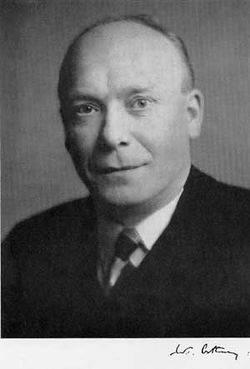وليام أستبري
وليام توماس أستبري FRS (بيل أستبري, 24 فبراير, 1898 - 4 يونيو, 1961) هو فيزيائي إنجليزي و بيولوجي جزيئي made pioneering X-ray diffraction studies of biological molecules. His work on keratin provided the foundation for Linus Pauling's discovery of the alpha helix. He also studied the structure for DNA in 1937 and made the first step in the elucidation of its structure.
X-ray diffraction studies of fibrous proteins
In 1928, Astbury was given a lectureship at the University of Leeds where he studied the properties of fibrous substances such as keratin and collagen with funding from the textile industry. (Wool is made of keratin.) These substances did not produce sharp patterns of spots like crystals, but the patterns provided physical limits on any proposed structures.
In the early 1930s, Astbury showed that there were drastic changes in the diffraction of moist wool or hair fibers as they are stretched significantly (100%). The data suggested that the unstretched fibers had a coiled molecular structure with a characteristic repeat of 5.1 Å (=0.51 nm). Astbury proposed that (1) the unstretched protein molecules formed a helix (which he called the α-form); and (2) the stretching caused the helix to uncoil, forming an extended state (which he called the β-form). Although incorrect in their details, Astbury's models were correct in essence and correspond to modern elements of secondary structure, the α-helix and the β-strand (Astbury's nomenclature was kept), which were developed twenty years later by Linus Pauling and Robert Corey in 1951. Hans Neurath was the first to show that Astbury's models could not be correct in detail, because they involved clashes of atoms. Interestingly, Neurath's paper and Astbury's data inspired H. S. Taylor (1941,1942) and Maurice Huggins (1943) to propose models of keratin that are very close to the modern α-helix.
In 1931, Astbury was also the first to propose that mainchain-mainchain hydrogen bonds (i.e., hydrogen bonds between the backbone amide groups) contributed to stabilizing protein structures. His initial insight was taken up enthusiastically by several researchers, including Linus Pauling.
Astbury's worked moved on to X-ray studies of many proteins (including myosin, epidermin and fibrin) and he was able to deduce from the diffraction patterns that the molecules of these substances were coiled and folded.
In 1937 Torbjörn Caspersson of Sweden sent him well prepared samples of DNA from calf thymus. The fact that DNA produced a diffraction pattern indicated that it also had a regular structure and it might be feasible to deduce it. Astbury reported that DNA's structure repeated every 2.7 nanometres and that the bases lay flat, stacked, 0.34 nanometres apart. At a symposium in 1938 at Cold Spring Harbor, Astbury pointed out that the 0.34 nanometre spacing was the same as amino acids in polypeptide chains. (The currently accepted value for the spacing of the bases in B-form of DNA is 0.332 nm.)
In 1946 Astbury presented a paper at a symposium in Cambridge in which he said: "Biosynthesis is supremely a question of fitting molecules or parts of molecules against another, and one of the great biological developments of our time is the realisation that probably the most fundamental interaction of all is that between the proteins and the nucleic acids." He also said that the spacing between the nucleotides and the spacing of amino acids in proteins "was not an arithmetical accident".
Astbury's was unable to propose the correct structure of DNA from his rudimentary data. However in 1952 Linus Pauling used Astbury's insufficient data to propose a structure for DNA, which was also incorrect. Nevetheless Astbury's insights led directly to the work of Maurice Wilkins and Rosalind Franklin and from there to the structure of DNA devised by Francis Crick and James D. Watson in 1953.
In later life he was given many awards and honorary degrees.
تاريخ وخبرات خاصة
المصادر
- Bailey K. (1961) "William Thomas Astbury (1898-1961): A Personal Tribute", Adv. Protein Chem., 17, x-xiv.
- Astbury WT and Woods HJ. (1931) "The Molecular Weights of Proteins", Nature, 127, 663-665.
- Astbury WT and Street A. (1931) "X-ray studies of the structures of hair, wool and related fibres. I. General", Trans. R. Soc. Lond., A230, 75-101.
- Astbury WT. (1933) "Some Problems in the X-ray Analysis of the Structure of Animal Hairs and Other Protein Fibers", Trans. Faraday Soc., 29, 193-211.
- Astbury WT and Woods HJ. (1934) "X-ray studies of the structures of hair, wool and related fibres. II. The molecular structure and elastic properties of hair keratin", Trans. R. Soc. Lond., A232, 333-394.
- Astbury WT and Sisson WA. (1935) "X-ray studies of the structures of hair, wool and related fibres. III. The configuration of the keratin molecule and its orientation in the biological cell", Proc. R. Soc. Lond., A150, 533-551.
- Neurath H. (1940) "Intramolecular folding of polypeptide chains in relation to protein structure", J. Phys. Chem., 44, 296-305.
- Taylor HS. (1942) "Large molecules through atomic spectacles", Proc. Am. Philos. Soc., 85, 1-12.
- Huggins M. (1943) "The structure of fibrous proteins", Chem. Rev., 32, 195-218.
قراءات إضافية
- Bernal, J. D. (1963). "William Thomas Astbury. 1898-1961." Biographical Memoirs of Fellows of the Royal Society. v. 9, p. 1-35.
- Olby, Robert (1970). "Astbury, William Thomas". Dictionary of Scientific Biography. Vol. 1. New York: Charles Scribner's Sons. pp. 319–320. ISBN 0684101149.

